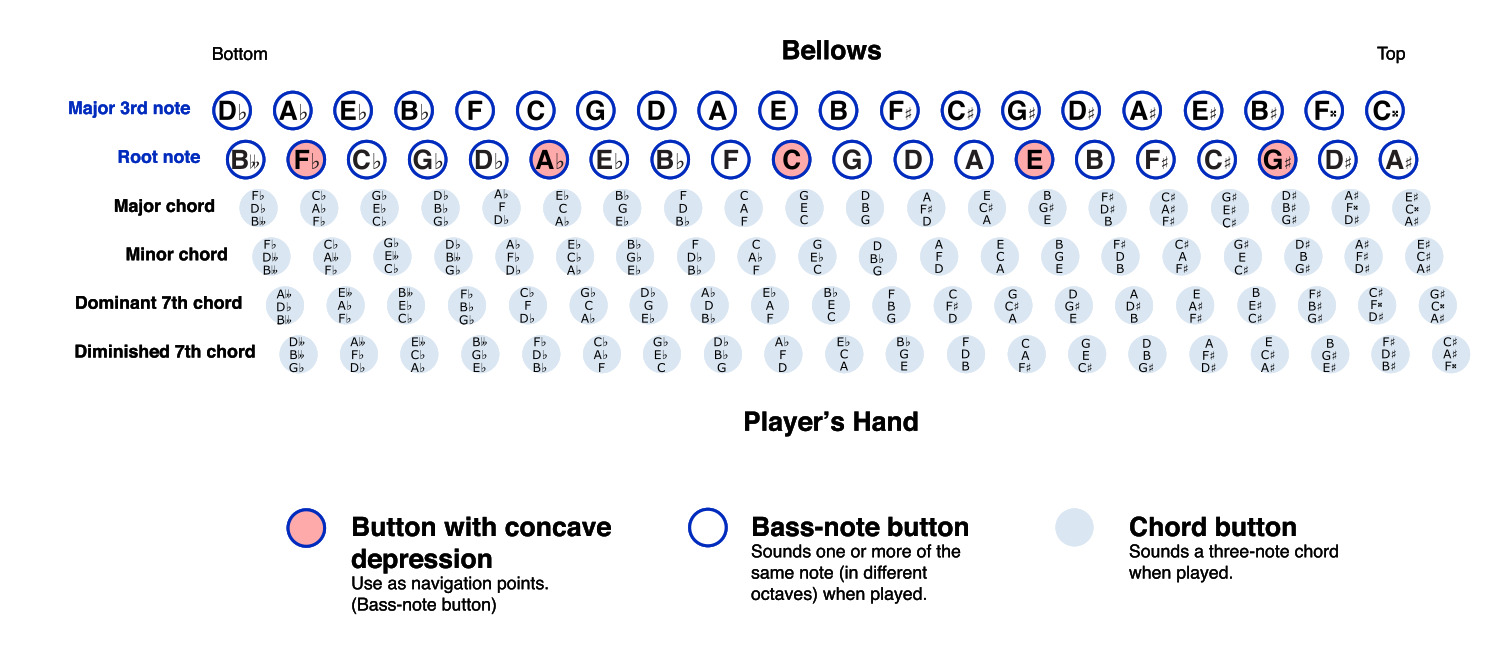Diminished Chords

Above image from https://en.wikipedia.org/wiki/Stradella_bass_system
The Stradella bass accordion can play a lot of chord types, but many are not all that obvious. In this article we will discuss the various “diminished chords”.
Had a buddy (guitar player) a number of years ago and he always called “diminished chords” by their proper name “demented”. Some days I think he was right!
So, what is a diminished chord and how is it notated?
Oh, it's all so complicated: to start off there are two kinds of diminished chords that we are concerned with.
- A diminished triad in which the third and fifth are flattened. You will also see this referred to as a “minor, flat 5”. In sheet music it is notated as “dim” or with a small circle, Co. So, a G diminished chord is Gdim or Go. But, you'll see “minb5” or, commonly, “mb5” as well, and I think this is actually helpful in keeping things clear.
- A diminished 7th chord in which the third, fifth, and seventh are flattened. This can be notated as C7dim or C7o. In both cases the notes are C, Eb, Gb and Bbb (note the last one here, that is a double flat ... it happens to be an A pitch, but repeat after me “it is a double flat!”.
It seems to be a “standard” in a lot of popular music and jazz that a Co is actually a C7o. And we are not going to change this misconception here. My advice is that if you think that the diminished 7th is not working, try a minb5.
There are only 3 diminished 7th chords. Uhh? What have you been smoking, Bob? Nothing, really. It's just that due to the way chords are inverted (and a lot more theory that I'm not going to regurgitate right now) it really does work out that way. If you are playing an instrument with more that one octave like piano or guitar you can argue that the notes are in different octaves. Yes, but you would be more wrong than right. In chord theory the order of the individual notes does not matter.
So, the chords C7o, D#7o, F#o and A7o all share the same notes. And are identical.
| Cdim7 | C, Eb, Gb, Bbb(A) |
| D#dim7 | D#(Eb), F#(Gb), A, C |
| F#dim7 | F#(Gb), A, C, Eb |
| Adim7 | A, C, Eb, Gb |
We have accounted for 4 of a total of 12 pitches.
Grab your circle of fifths chart. Notice how each set above is separated by 2 entries in the circle of 5ths.
In accordion stradella the 5th is omitted. So, the notes for the above chords become:
| Cdim7 | C, Eb, Bbb(A) |
| D#dim7 | D#(Eb), F#(Gb), C |
| F#dim7 | F#(Gb), A, Eb |
| Adim7 | A, C, Gb |
Now, we add the 5th via a counterbass. So, when we play Cdim7 we add the missing flat fifth (Gb) by playing the counterbass of D (actually a F#, but that's the same thing) and we end up with a 4 note diminished chord. In most cases we play something like bass-note, chord, bass, chord (assuming 4/4), but we can also press the bass-note (in this case Gb and the chord button, Cdim) at the same time. The same fingering (counter-bass, two columns up) applies to all diminished seventh chords.
So, here is our complete set of diminished equivalent seventh chords, including the enharmonic (different spelling, same pitches) spellings. And, yes I understand that this is not correct in a music theory class, but geez, Louise!
| C/B# | A | Gb/F# | Eb/D# |
| G | E/Fb | Db/C# | Bb/A# |
| D | B/Cb | Ab/G# | F/E# |
Diminished triads (also notated as minor flat 5) are pretty easy. Just pop down three columns and play the diminished button in conjunction with the original root. If it helps, think of playing the diminished chord of the minor third of the chord.
What this means is that for a Cdim (mb5) you press the Eb diminished button. Again, referring to the chart at the top of the page you will see that this generates C, Eb and Gb. For a bass note you can play the Eb bass note, or the reach up and hit the C. Simple!
 |
This page was last modified on 2025-05-04 |